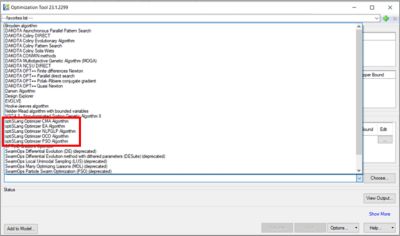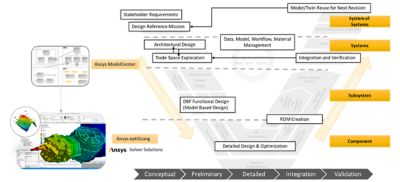-
-
Software gratuito per studenti
Ansys potenzia la nuova generazione di ingegneri
Gli studenti hanno accesso gratuito a software di simulazione di livello mondiale.
-
Connettiti subito con Ansys!
Progetta il tuo futuro
Connettiti a Ansys per scoprire come la simulazione può potenziare la tua prossima innovazione.
Paesi e regioni
Customer Center
Supporto
Partner Community
Contatta l'ufficio vendite
Per Stati Uniti e Canada
Accedi
Prove Gratuite
Prodotti & Servizi
Scopri
Chi Siamo
Back
Prodotti & Servizi
Back
Scopri
Ansys potenzia la nuova generazione di ingegneri
Gli studenti hanno accesso gratuito a software di simulazione di livello mondiale.
Back
Chi Siamo
Progetta il tuo futuro
Connettiti a Ansys per scoprire come la simulazione può potenziare la tua prossima innovazione.
Customer Center
Supporto
Partner Community
Contatta l'ufficio vendite
Per Stati Uniti e Canada
Accedi
Prove Gratuite
ANSYS BLOG
July 18, 2023
Ansys ModelCenter Now Includes Ansys optiSLang Optimization Algorithms
In today's rapidly evolving engineering landscape, the ability to efficiently bridge the gap between system-level conceptual design and detailed component design is crucial. This process involves refining multidisciplinary design requirements, validating design iterations through physics-based simulations, and optimizing design parameters to achieve the best trade-offs early in the design cycle. Ansys ModelCenter, integrated with the powerful multiparameter optimization algorithms from Ansys optiSLang, offers a transformative workflow that seamlessly connects these phases, enabling engineers to design cutting-edge solutions while considering cost constraints.

The integration of optiSLang optimization algorithms inside ModelCenter provides a unique solution, spanning from system-level conceptual design to detailed component design and optimization.
ModelCenter acts as a system integration platform, connecting requirements from a system architecture modeler environment and providing a unified environment for managing and executing simulations from various software tools. ModelCenter's power lies in its ability to automate the simulation and optimization process. Engineers can create workflow templates that connect different tools, pass data between simulations, and perform automated optimization loops. By harnessing the power of ModelCenter, engineers can efficiently orchestrate the entire design process, ensuring consistent results and saving significant time and effort.
Unlocking the Power of Design Optimization with optiSLang and ModelCenter
Ansys optiSLang is used by a wide range of industries for parametric design exploration, optimization, and robustness analysis in combination with any simulation or computer-aided engineering (CAE) tool. By leveraging these five best-in-class optiSLang optimizers, ModelCenter users can now identify the most optimal design quickly and efficiently. Let’s compare the use cases for each of these algorithms.

Ansys solutions for digital transformation and model-based systems engineering (MBSE).
- Nonlinear Programming by Quadratic Lagrangian Algorithm (NLPQL)
- The NLPQL approach is the preferred approach as a gradient-based optimization method. NLPQLP uses nonlinear programming with non-monotone and distributed line search. It is very efficient in low dimensions with up to 20 design variables (if derivatives are accurate enough). The efficiency decreases with increasing number of variables and constraints.
- Evolutionary Algorithm
- Evolutionary algorithms (EAs) are stochastic search methods that mimic processes of natural biological evolution like selection, recombination, and mutation. They are used for discrete and continuous design variables, single and multi-objective optimization tasks, and problems with a large ratio of failed designs. EAs are more efficient than gradient-based and response surface-based methods if the number of design variables and constraint conditions is large. They are also more efficient than NLPQLP for large numbers of variables.
- Covariance Matrix Adaptation Algorithm
- The covariance matrix adaption (CMA) algorithm is a stochastic evolution strategy for real-parameter optimization of nonlinear, nonconvex functions. They are used in a rugged search landscape, which can comprise discontinuities, sharp ridges, or local optima. In contrast to most classical methods, fewer assumptions on the nature of the underlying objective function are made. Only the ranking between candidate solutions is exploited to learn the sample distribution, and neither derivatives nor the function values themselves are required.
- Particle Swarm Optimization Algorithm
- The particle swarm algorithm is a population-based global optimization algorithm in which each population consists of a given number of particles that move through the design space. PSO works similarly to EA for single and multi-objective optimization problems and can handle many failed designs.
- One-Click Optimizer
- The one-click optimizer (OCO) is an efficient hybrid optimization strategy that comes with only one major setting to be tuned: the maximum number of design evaluations. This provides the ability to dynamically switch between optimization algorithms and run multiple algorithms simultaneously. OCO is one of the most reliable and efficient optimization strategies.

Ansys optiSLang optimizers and how they compare to each other
The integration of optiSLang optimizers is a great addition to ModelCenter, enabling efficient parameter optimization, design exploration optimal trade-off identification, and cost-effective solutions.
See how Ansys optiSLang and Ansys ModelCenter can help you.